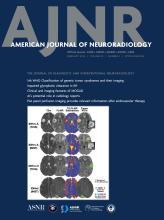We read with keen interest the recent article titled “Realistic Productivity in Academic Neuroradiology: A National Survey of Neuroradiology Division Chiefs.”1 Many studies have reported on the correlation between diagnostic errors and an increase in workload volume, prompting claims for guidelines that define a range of cross-sectional studies that can be safely interpreted in a typical workday.2,3
The Japanese College of Radiology (JCR), a bastion of two-thirds of the board-certified radiologists in Japan, was established in 1973. The JCR is an organization including diagnostic radiologists, interventional radiologists, nuclear medicine physicians, and radiation oncologists as members. Owing to the world’s leading concentration of CT and MR imaging scanners alongside one of the lowest ratios of radiologists per capita based on the data of the Organization for Economic Co-operation and Development (OECD), the workload of Japanese radiologists exceeds the OECD average by 4-fold.4 Consequently, Japanese radiologists have been required to work at very intense paces, even at academic/educational institutions. In this context, the JCR released a position statement on the appropriate workload for radiologists in 2022. This position statement reads, “To maintain the quality of radiology services, the number of radiologists’ reports should ideally be limited to less than four cross-sectional studies per hour of uninterrupted reading time (ie, protected time excluding activities such as scheduling, conferences, and consultations).” This document can be found on our web page (https://jcr.or.jp/site/wp-content/uploads/2023/09/JCR_statement_on_appropriate_workload_of_radiologists_Updated_on_March_242022_en.pdf).
Our statement may resonate very well with the “median of 32 cross-sectional studies as a reasonable and safe threshold for interpretation during a standard clinical day” stated in the article by Wintermark et al.1 There are minor differences between this survey and the statement by the JCR. Our recommendation of 4 cases per hour includes the interpretation of CT, MR imaging, and PET/CT across the entire body. This number is based on the optimal interpretation durations for various representative imaging studies and their ratio in average high-volume Japanese institutions. This number should be further reduced in teaching institutions, aligning with that in the survey reported in the article discussed in this letter.1
Our work goes beyond image interpretations. We radiologists have to make decisions regarding choosing the appropriate imaging modalities, managing the optimal protocols, and giving instructions to technologists. In addition, prompt and effective communication with referring physicians is vital for patient safety. All of these activities are time-consuming. It is, therefore, necessary to establish international guidelines for a safe number of interpreted cross-sectional studies per day to maintain the quality of our radiology services worldwide.
Footnotes
Disclosure forms provided by the authors are available with the full text and PDF of this article at www.ajnr.org.
References
- Received August 14, 2023.
- Accepted after revision August 21, 2023.
- © 2024 by American Journal of Neuroradiology












